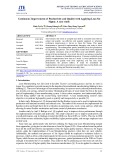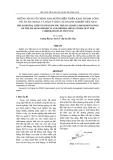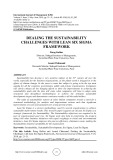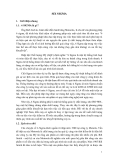
15
2
CHAPTER
The Strategic
Component of
Six Sigma
In this chapter, we describe the strategic component of Six
Sigma. First, we describe what management must do to create Six
Sigma as a true management philosophy in your company; that is,
using it as a strategic weapon. The strategy of Six Sigma is called
Business Process Management. We address what it is and provide
an example. While you may not be directly involved in the strate-
gic creation of Six Sigma, your involvement in later project teams
is a direct result of the creation of Six Sigma as a strategy in your
organization. Learning what your management has done to create
Six Sigma as a vibrant management philosophy will motivate you
to see your place in the organization as Six Sigma is implemented.
The Strategy of Six Sigma
Quality initiatives have come and gone. You may have been part of
one either in your current job or another place you have worked.
Chances are these initiatives failed because their implementation
involved jumping immediately into quality tactics without creating
a strategy for the tactics to work.

16 SIX SIGMA FOR EVERYONE
A strategy may be defined as a plan or method for obtaining
some goal or result. Unlike other quality initiatives, Six Sigma has a
strategic component aimed at not only developing management’s
commitment to Six Sigma, but their active involvement.
One of the problems with previous quality initiatives is that the
workforce soon came to see the quality activities as nothing more
than a way for them to work harder. They saw how they had to
change the way they worked and how they had to participate in
teams, learning new concepts, but they didn’t see management
changing. In fact, with some quality initiatives the workforce soon
saw that management would use the increased work to downsize
the organization. When experts would analyze the results of a
failed quality effort, high on the list of reasons behind the failure
was the lack of management support.
Six Sigma is different because the work first and foremost be-
gins with management. Management of any organization is respon-
sible for the strategy of how work gets done (a plan or method for
obtaining some goal or result). As a management strategy, Six Sigma
is the plan or method for obtaining the goals or results of the busi-
ness. To better understand how Six Sigma operates as a strategy,
let’s first put you in the position of executive management.
You have just been promoted as the chief executive officer of
Fast Food Is Us. You inherit a company that has not been as prof-
itable as it should be. You learn that any business must have a set
of business objectives. Your board of directors has indicated you
have five major strategic business objectives. They are:
1. Revenue.
2. Profit margin.
3. Customer satisfaction.
4. Growth.
5. Employee satisfaction.
As the chief executive officer, your success will be determined
exclusively based on improvement of each of these objectives. Tra-
ditional management indicates that you have a group of vice presi-
dents who manage a group of functions that hopefully drive

The Strategic Component of Six Sigma 17
achievement of these objectives. Figure 2.1 shows the traditional
functions that have existed at Fast Food Is Us.
While you inherited the vice presidents, they are all hardwork-
ing and dedicated . . . to the achievement of their functional ob-
jectives. Each function has a set of objectives. For example, the
vice president of food and beverage wants to make sure there is
sufficient scheduling, delivery, and proper storage of food materi-
als necessary to run the stores. The vice president of maintenance
wants to ensure proper energy sources and back ups for each
store. The operations vice president wants to ensure sufficient
staffing. These functional goals and objectives are understandable
but at times the functional objectives may be in conflict with the
overall strategic objectives of the organization. For example, the
vice president of food and beverage may want to hold unnecessary
inventory so she isn’t the cause of complaints regarding food.
Holding inventory will impact revenue. Inventory may also impact
customer satisfaction if freshness becomes an issue.
The focus of functional objectives denies the organization be-
coming world class. World class organizations have three major
focus areas: being customer focused, process focused, and em-
ployee focused. As the preceding paragraph shows, your vice presi-
dents want their functions to excel. As Figure 2.1 shows, the
geometric shape of how most organizations are structured is verti-
cal. However, customers don’t go through our organization through
a series of functions. Instead, recognize that customers go through
your organization through a series of processes.
Aprocess is a series of steps or activities that take inputs, add
value, and produce an output. In our food example, our customers
don’t go through the food and beverage function. Instead, they go
through a process that can be called the food delivery process.
This process touches multiple functions (food and beverage, oper-
ations, and maintenance to name a few).
Thus, to create a Six Sigma strategy, it is the responsibility of
management to identify the key processes of their organization,
measure their effectiveness and efficiency, and initiate improve-
ment of the worst performing processes.
Therefore, if you were the chief executive officer of Fast Food
Is Us, your first responsibility would be to identify those processes.

18
Figure 2.1 Fast Food Is Us—organizational chart.
Vice President
Food and Beverage
Vice President
Procurement
Vice President
Human Resources
Vice President
Maintenance
Vice President
Finance
Vice President
Operations
Chief Executive Officer
(You)

The Strategic Component of Six Sigma 19
Identifying these processes is best done with your current reports.
Part of the goal of brainstorming the key processes of the organiza-
tion is to educate management of the hazards of their current way
of doing business. Thus, when the key managers get together in the
same room and begin identifying processes, they are at the same
time recognizing that there must be a better way to manage the
business. Figure 2.2 shows a partial list of the key processes of a
company like Fast Food Is Us.
Once management identifies their key processes, it is impor-
tant for them to assign process ownership. In some cases, process
owners will be current management. In other cases, a process
owner might be taken from nonmanagement. The criteria for a
process owner includes the following:
• A subject matter expert.
• Someone who experiences the gain if the process is working
well and the pain if the process is working poorly.
• Someone who has respect among employees in preceding
and subsequent processes.
• Someone with an aptitude for process thinking and im-
provement.
The process owner has the responsibility to acquire the key mea-
sures of performance for the processes they own. In Chapter 1, we
said that Six Sigma improves the effectiveness and efficiency of the
organization. To do this strategically, process owners are chartered
with going out and first determining what the measures of effective-
ness and efficiency are for the process (or processes) they own.
For example, let’s say that Paula Pangborn is the process
owner for food ordering. It would be Paula’s responsibility to de-
termine the measures of effectiveness and efficiency for food or-
dering. The first activity is to find out who is the customer of the
food ordering process. Ultimately, the customer of the food order-
ing process is the external customer who orders a cheeseburger
and fries. However, of far more importance are the most immedi-
ate customers of the food ordering process, which in this case are
the food preparation employees. In this case, the process that fol-
lows the food ordering process is the food preparation process.













![Tối ưu hóa hiệu suất hệ thống: Bài thuyết trình [Chuẩn nhất]](https://cdn.tailieu.vn/images/document/thumbnail/2025/20251107/hiepdz2703@gmail.com/135x160/35941762488193.jpg)




![Bài giảng Quản trị chất lượng trong công nghiệp thực phẩm [chuẩn nhất]](https://cdn.tailieu.vn/images/document/thumbnail/2025/20250805/vijiraiya/135x160/637_bai-giang-quan-tri-chat-luong-trong-cong-nghiep-thuc-pham.jpg)

![Đề cương bài giảng Kỹ năng hoạt động công nghiệp [mới nhất]](https://cdn.tailieu.vn/images/document/thumbnail/2025/20250715/kimphuong1001/135x160/76971752564028.jpg)


![Bài giảng Kỹ thuật điều độ trong sản xuất và dịch vụ [mới nhất]](https://cdn.tailieu.vn/images/document/thumbnail/2025/20250630/dcbaor/135x160/13121751251866.jpg)


